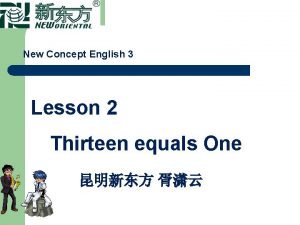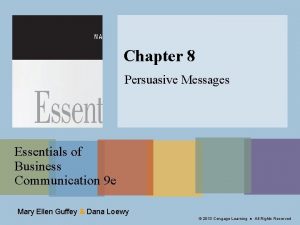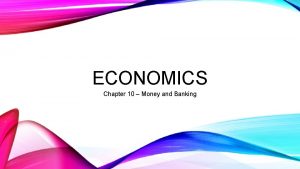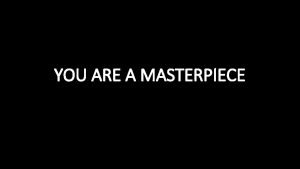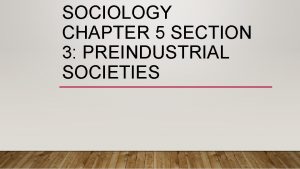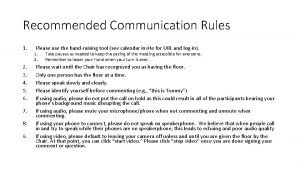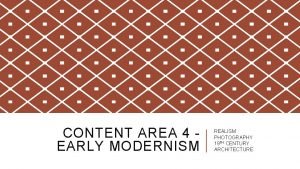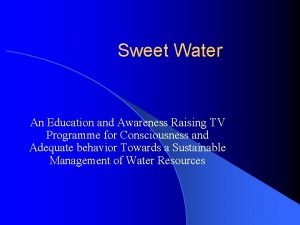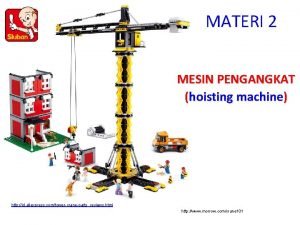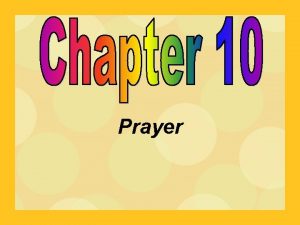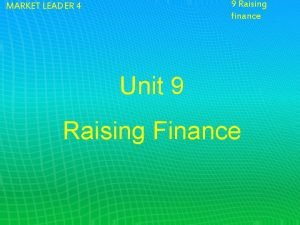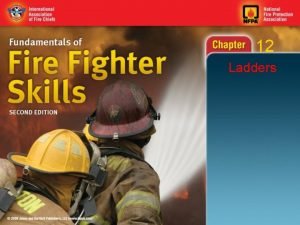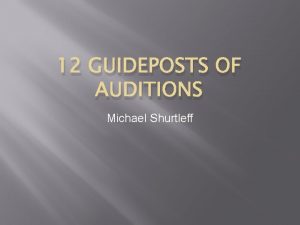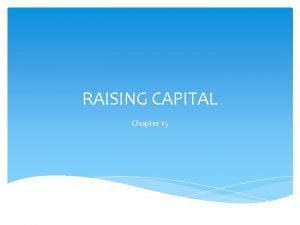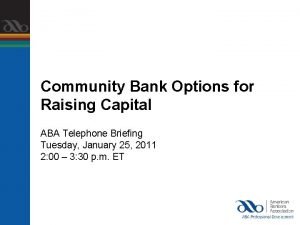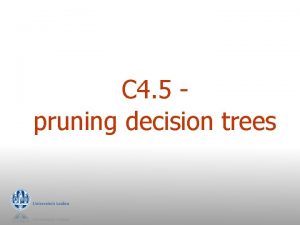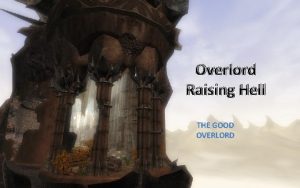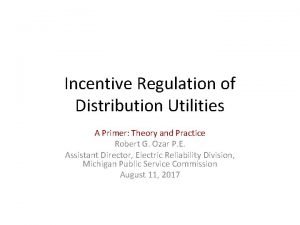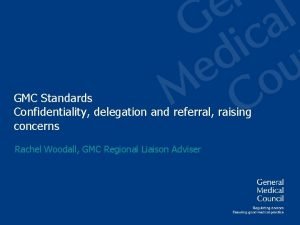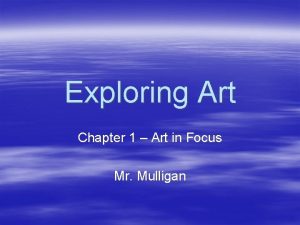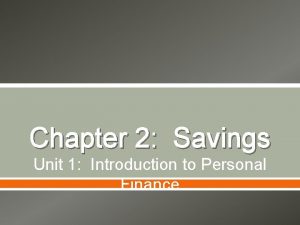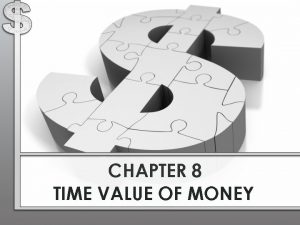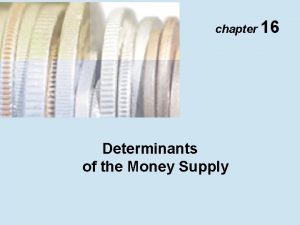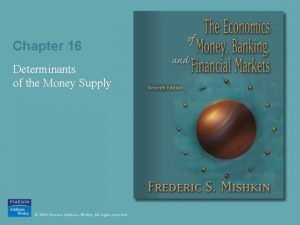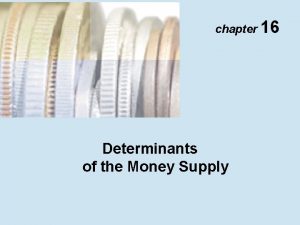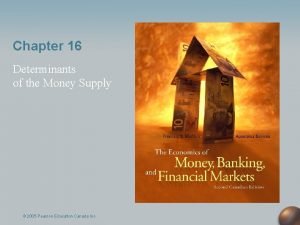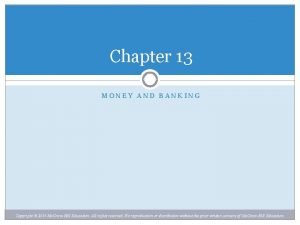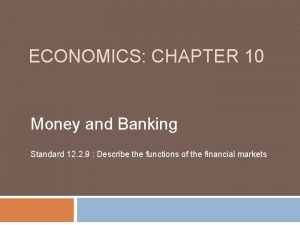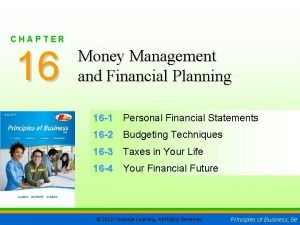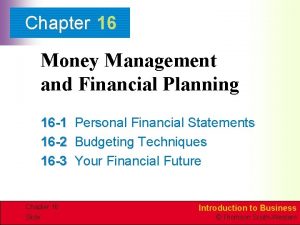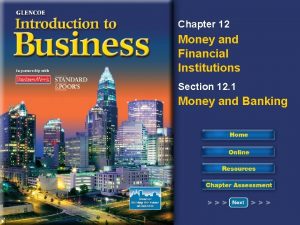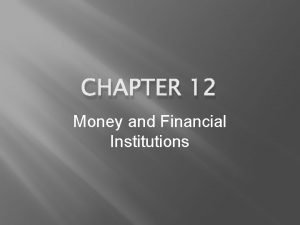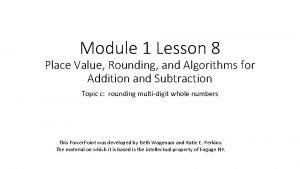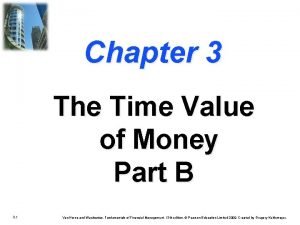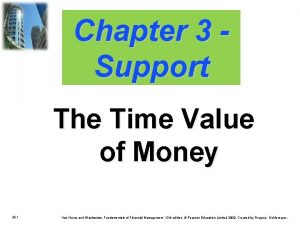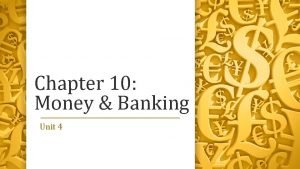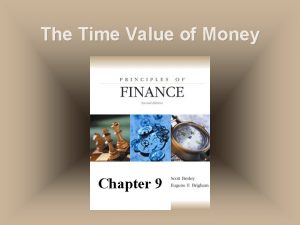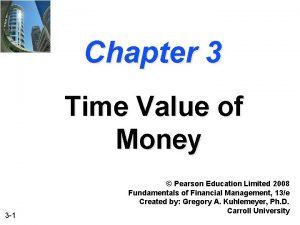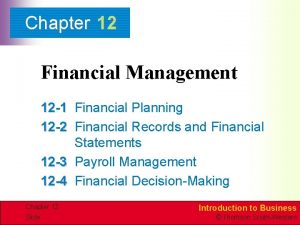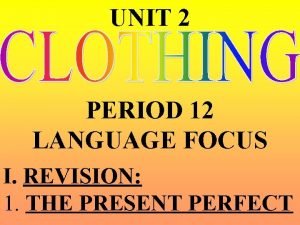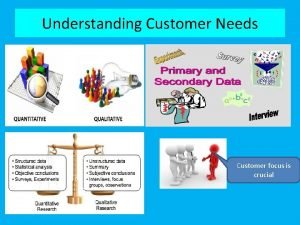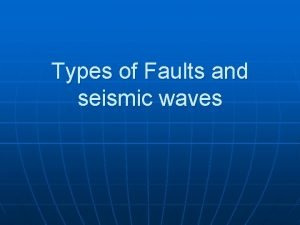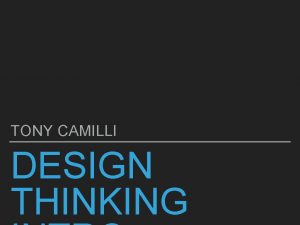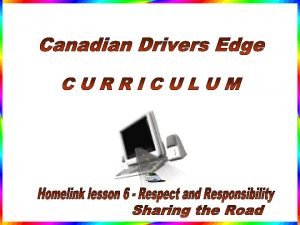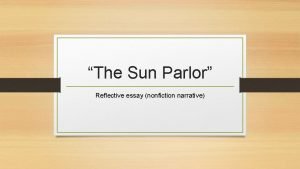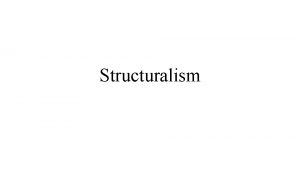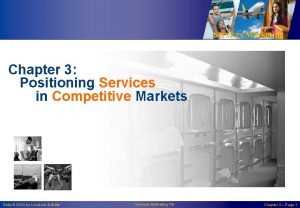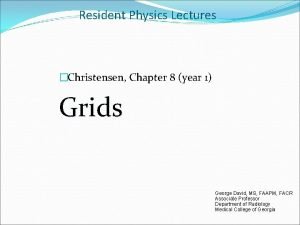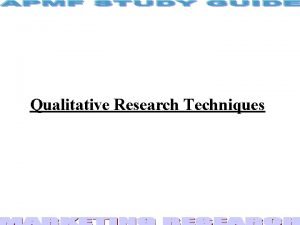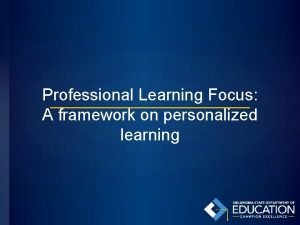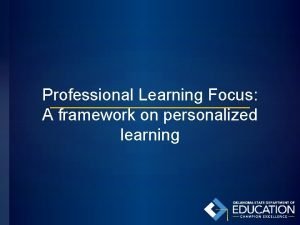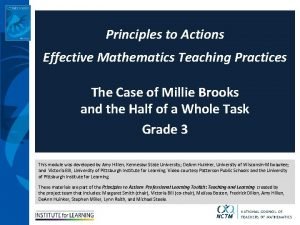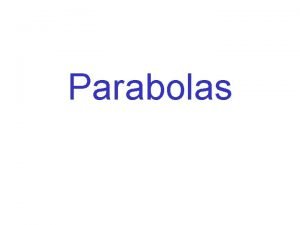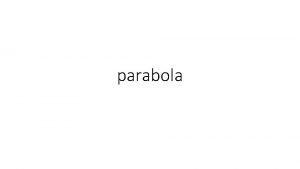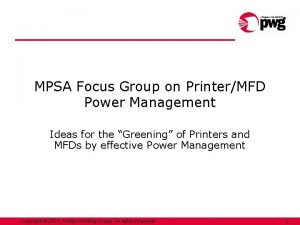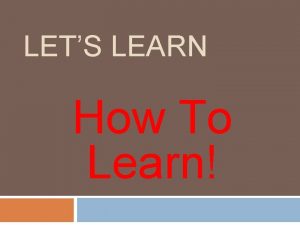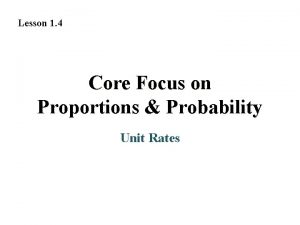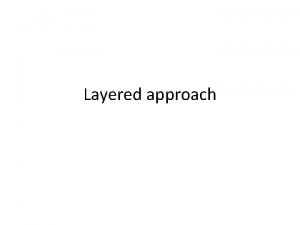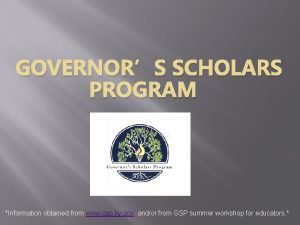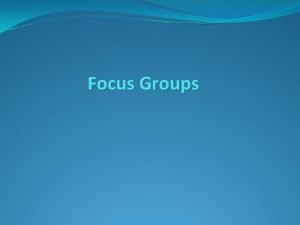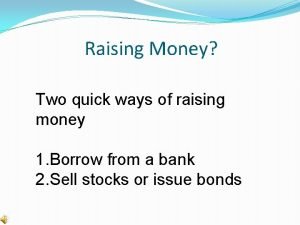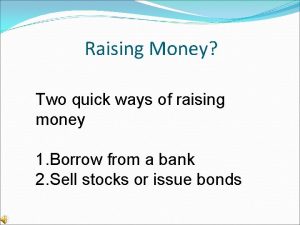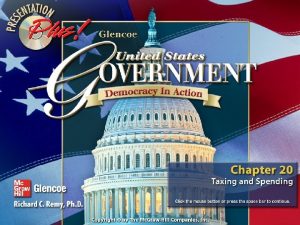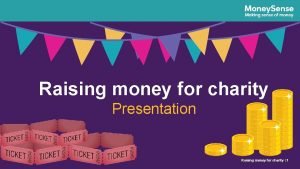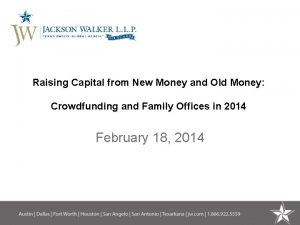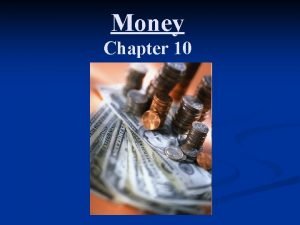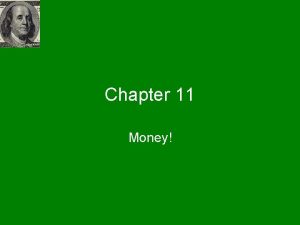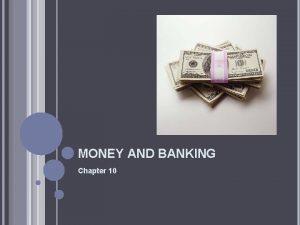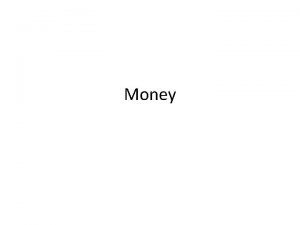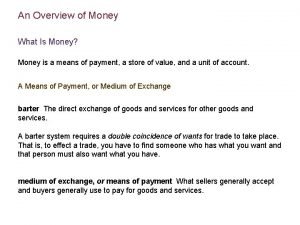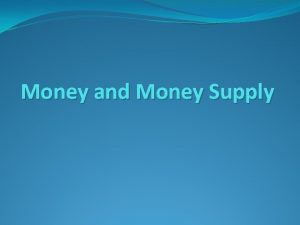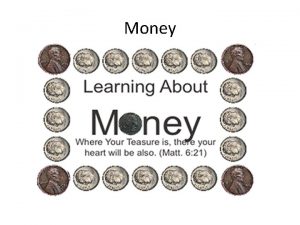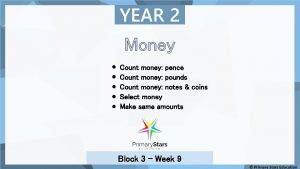Chapter Focus Section 1 Raising Money Section 2



































































































- Slides: 99


Chapter Focus Section 1 Raising Money Section 2 Preparing the Federal Budget Section 3 Managing the Economy Chapter Assessment


Chapter Objectives • Raising Money Identify the kinds of taxes and the methods of borrowing the government uses to raise money. • Preparing the Federal Budget Describe the roles of the executive and legislative branches in the preparation of the federal budget. • Managing the Economy Explain the influence of fiscal and monetary policies on the economy.


Raising Money Key Terms taxes, taxable income, dependent, withholding, securities, national debt Find Out • How does the income tax compare with other sources of federal revenue in terms of the amount collected? • How does the federal government use tax laws to affect economic decisions?

Raising Money Understanding Concepts Civic Participation How are income taxes collected from citizens of the United States? Section Objective Identify the kinds of taxes and the methods of borrowing the government uses to raise money.

Representative Dick Armey (R-Texas) keeps his constituents informed on issues through his Web page. Among other things, the page features a daily update of the amount of the national debt. On October 15, 2000, the debt equaled $5, 653, 997, 843, 075. 88. To pay off the debt, each American would have to contribute $21, 152. 21. The interest on the national debt is one of the largest expenses of the federal government.

I. Taxes as a Source of Revenue (pages 555– 558) A. Individual income taxes are the government’s largest source of revenue. 1) The income tax is progressive, that is, it is based on ability to pay. 2) April 15 each year is the deadline for filing income tax returns. 3) The Internal Revenue Service (IRS) collects taxes during the year through its regional centers. B. Corporations, too, pay income taxes on income they earn beyond expenses and deductions.

I. Taxes as a Source of Revenue (pages 555– 558) C. The federal government collects social insurance taxes paid equally by employees and employers to pay for Social Security and Medicare. D. Excise taxes are federal taxes on the manufacture, transportation, sale, and consumption of goods like gasoline, tires, oil, liquor, and cigarettes, and the performance of services. E. Customs duties are levied on goods imported into the United States. F. The federal government collects an estate tax on the property and money above a set amount when someone dies.

I. Taxes as a Source of Revenue (pages 555– 558)

I. Taxes as a Source of Revenue (pages 555– 558) Do you agree or disagree with the policy that exempts colleges, labor unions, churches, and other nonprofit groups from paying income taxes? Explain. Students should weigh the value of nonprofit organizations against loss of revenue.

II. Taxes and the Economy (pages 558– 559) A. U. S. tax laws are complex and filled with special provisions. B. Tax exemptions, or loopholes, favor certain groups and encourage activities such as oil exploration. C. The Tax Reform Act of 1986 reduced many tax exemptions, tax credits, and tax shelters, and the number of tax brackets. D. The federal government today provides tax credits to people in lower income brackets.

II. Taxes and the Economy (pages 558– 559) What are some benefits and losses associated with the tax credits policy for people with lower incomes? Answers will vary. Tax credits are a way of shifting the tax burden to those most able to pay.

III. Borrowing for Revenue (page 559) A. In addition to collecting taxes, the federal government borrows to raise money by selling federal securities, such as bonds, notes, and certificates, on which it pays interest. B. The accumulated moneys the government borrows is the national debt.

III. Borrowing for Revenue (page 559) Why does the federal government sell securities to individuals, corporations, and other institutions, and how does this affect the national debt? The government sells securities to raise revenues. This is a form of borrowing that adds to the national debt.

Checking for Understanding 1. Main Idea Use a graphic organizer like the one below to show the steps in collecting federal income tax. Employers withhold estimated taxes from workers’ pay and send the money to the IRS; self-employed people pay an estimated tax 4 times per year; by April 15 the following year, each taxpayer must file a return and send any amount still owed.

Checking for Understanding Match the term with the correct definition. ___ F taxes ___ C taxable income ___ A dependent ___ D withholding ___ B securities ___ E national debt A. one who depends primarily on another person for basic needs B. financial instruments that are sold as a means of borrowing money with a promise to repay the buyer with interest after a specific time period C. the total income of an individual minus certain deductions and personal exemptions D. the money an employer withholds from workers’ wages as payment of anticipated income tax E. the total amount of money the government owes at any given time F. money that people and businesses pay to support the activities of the government

Checking for Understanding 3. Identify progressive tax, IRS, social insurance taxes, regressive tax, tax loophole. A progressive tax is a tax based on a taxpayer’s ability to pay. The IRS, or Internal Revenue Service, is the bureau of the United States Treasury Department responsible for collecting taxes. Social insurance taxes are taxes collected to pay for major social programs such as Social Security, Medicare, and unemployment compensation. A regressive tax is a tax in which people with lower incomes pay a larger portion of their income. A tax loophole is an exemption from taxes.

Checking for Understanding 4. What is the federal government’s biggest single source of tax revenue? The federal government’s biggest single source of tax revenue is the individual income tax.

Critical Thinking 5. Identifying Alternatives Why does the government raise most of its revenues through taxing rather than borrowing? Although taxes are unpopular, borrowing costs the government a huge amount of interest, adds to the national debt, and threatens the nation’s economic security.

Civic Participation Obtain a paycheck stub—yours or a family member’s. Note the categories and amounts of money deducted for city and state taxes, FICA, and Social Security. Create a graph that shows the percentage of the earned wages deducted in each category.


Preparing the Federal Budget Key Terms fiscal year, uncontrollables, entitlement, incrementalism Find Out • How do the executive and legislative branches work together to produce an annual budget for the federal government? • Why is it so difficult for the federal government to reduce spending or raise taxes in order to balance the budget?

Preparing the Federal Budget Understanding Concepts Public Policy What factors prevent the budget from changing very much from year to year? Section Objective Describe the roles of the executive and legislative branches in the preparation of the federal budget.

In August 1997, Congress and the president agreed to enact a balanced federal budget for the first time in 30 years. In reaching this historic agreement, President Clinton and the Republicancontrolled Congress cut individual income taxes by $94 billion and pledged to reduce the federal deficit by $182 billion over the next 5 years.

I. Drawing Up the President’s Budget (pages 560– 562) A. Since 1921 the president has been responsible for preparing the budget. B. The Office of Management and Budget (OMB) collects spending requests from each federal agency and analyzes the nation’s economic situation. The president, the OMB director, the secretary of the treasury, and the president’s Council of Economic Advisors (CEA) discuss how the proposed budget may affect the administration’s general policies and goals.

I. Drawing Up the President’s Budget (pages 560– 562) C. The White House returns guidelines to the federal agencies to help them prepare their final budgets. D. Before the final budget is presented to Congress, the OMB submits a complete budget to the president for final review and approval. E. About 70 percent of spending in the federal budget is uncontrollables, or expenditures required by law or resulting from previous commitments, such as Social Security, government pensions, Medicare, veterans’ benefits and interest on the national debt.

I. Drawing Up the President’s Budget (pages 560– 562)

I. Drawing Up the President’s Budget (pages 560– 562) How do the OMB, the CEA, and the Department of the Treasury work with the president in preparing the federal budget each year? OMB: Gives first set of figures to the president. CEA and Treasury: Make decisions on the effect of budget decisions on policy goals.

II. Congressional Budget Action (pages 562– 564) A. The Constitution requires that Congress approve all federal spending; only Congress has the power to raise revenue and pass appropriations. B. Congress can revise the president’s budget, and key lawmakers must often negotiate with the president about budget proposals.

II. Congressional Budget Action (pages 562– 564) C. The Congressional Budget Act of 1974 set up House and Senate Budget Committees and the Congressional Budget Office (CBO) to centralize and evaluate the federal budget for Congress. D. The Gramm-Rudman-Hollings Act of 1985 aimed to force the president and Congress to work together to reduce the huge federal budget deficits.

II. Congressional Budget Action (pages 562– 564) E. Congress 1) reviews the president’s budget proposals, 2) reconciles differences between the House and Senate taxing and spending plans, and 3) carries out the procedures in the Gramm-Rudman-Hollings Act. F. The Budgetary Enforcement Act (BEA) of 1990 divided the budget into domestic policy, defense, and international affairs, and said any spending that exceeded the budgeted limit in any area would come out in the next year’s funding for that area.

II. Congressional Budget Action (pages 562– 564) In what ways are the conflicts over the budget between the president and Congress beneficial and troublesome for taxpayers? Beneficial: Negotiated budget is more carefully planned. Troublesome: Impasse can delay programs or shut down government.

III. Incremental Budget Making (page 564) A. The federal budget-making process is based on incrementalism. B. Incrementalism means that federal agencies usually can assume they will get at least the same amount of money they received in the previous year.

III. Incremental Budget Making (page 564) For which federal agencies would you like to see the budget increased or decreased? Explain. Answers will vary. Students may list budget priorities. They should support their choices with logical reasons.

Checking for Understanding 1. Main Idea Use a graphic organizer like the one below to show the budget process is affected if Congress and the president are from different political parties. Cause—president and Congress are from different parties; Effect—budget is slowed due to the need for compromise

Checking for Understanding 2. Define fiscal year, uncontrollables, entitlement, incrementalism. A fiscal year is a 12 -month accounting period. Uncontrollables are government expenditures required by law or resulting from previous budgetary commitments. An entitlement is a required government expenditure that continues from one year to the next. Incrementalism is the term used to explain that the total budget changes little from year to year.

Checking for Understanding 3. Identify Office of Management and Budget, Congressional Budget Office. The Office of Management and Budget, or OMB, is responsible for the actual day-to-day preparation of the federal budget. The Congressional Budget Office, or CBO, is responsible for carefully evaluating the overall federal budget for Congress and acting as a counterbalance to the OMB in the executive branch.

Checking for Understanding 4. Identify four entitlements that are a part of the federal budget. Any four: Social Security, pensions for retired government employees, Medicare, Medicaid, veterans’ benefits

Critical Thinking 5. Expressing Problems Clearly Why does the federal government find it difficult to raise taxes or reduce spending to balance the budget? People do not want to pay more taxes, and the budget contains about 70 percent uncontrollables or entitlements.

Public Policy Imagine that you are a part of a presidential committee set up to decide the spending priorities for next year’s government budget. Your job is to list the four top areas that you think should have the greatest share of the budget. Prepare a supporting argument for the four areas you have chosen.


Managing the Economy Key Terms fiscal policy, monetary policy, gross national product (GNP), discount rate, reserve requirement, open-market operations Find Out • What is the difference between fiscal policy and monetary policy? • What are the four major categories of federal government spending?

Managing the Economy Understanding Concepts Public Policy Why must the Fed operate free of pressures from Congress or the president? Section Objective Explain the influence of fiscal and monetary policies on the economy.

The Federal Reserve Board (the Fed) plays a key role in the nation’s economy. The Fed determines the interest rates member banks pay to borrow money. When the chairman of the Fed’s Board of Governors testifies before a congressional committee, the stock market sometimes overreacts. On October 27, 1997, not long after Chairman Alan Greenspan suggested that stock prices might be getting too high, the stock market plunged more than 554 points. Even though the market soon recovered this loss, the experience revealed how closely investors pay attention to the words and actions of the Fed.

I. Where the Money Goes (pages 566– 567) A. Most of the federal government’s annual $2 trillion in spending goes to direct benefits for individuals, national defense, discretionary spending, and interest on the national debt. B. Spending for Social Security, social-welfare, and health-care programs is one of the biggest items in the federal budget. C. Spending for defense has increased since 2000 after decreasing during the 1990 s. D. Federal grants to state and local governments help to pay for public housing, road repairs, school lunch programs, flood insurance, and other services.

I. Where the Money Goes (pages 566– 567)

I. Where the Money Goes (pages 566– 567) Why do you think spending for national defense declined following the end of the Cold War? National security needs were changing as the major threat to national security was gone.

II. Fiscal and Monetary Policy (pages 567– 568) A. Beginning with the Great Depression of the 1930 s, the federal government’s role in managing the nation’s economy has expanded. B. The federal government influences the direction of the nation’s economy by its fiscal policy. C. The government also uses monetary policy to influence the direction of the economy.

II. Fiscal and Monetary Policy (pages 567– 568)

II. Fiscal and Monetary Policy (pages 567– 568) What tools does the federal government use to influence and manage the nation’s economy? Fiscal and monetary policy.

III. The Federal Reserve System (pages 568– 570) A. The Federal Reserve System’s 12 Federal Reserve Districts make up the central banking system of the United States. B. A seven-member Board of Governors, which supervises the Fed, is appointed to four-year terms by the president but is independent of both Congress and the president. C. The Board of Governors supervises the operations of the Federal Reserve Banks and determines the money and credit policies of the nation.

III. The Federal Reserve System (pages 568– 570) D. The Board of Governors 1) fixes the discount rate, 2) raises or lowers the reserve requirement, and 3) puts money into the economy through open market operations.

III. The Federal Reserve System (pages 568– 570) How does the Board of Governors of the Federal Reserve System carry out its duties to determine the general money and credit policies of the United States? Changing the discount rate and the reserve requirement; buying securities on the open market.

Checking for Understanding 1. Main Idea Use a graphic organizer like the one below to compare recent federal grants with those in the 1980 s—number of grants for infrastructure investment declined; Recently—grants for public welfare programs increased

Checking for Understanding Match the term with the correct definition. ___ B fiscal policy ___ E monetary policy A. the interest rate the Federal Reserve System charges member banks for loans ___ D gross national product B. a government’s use of spending and taxation to influence the economy ___ A discount rate C. the percentage of money member banks must keep in Federal Reserve Banks as a reserve against their deposits. ___ C reserve requirement D. the sum of all goods and services produced in a nation in a year E. a government’s control of the supply of money and credit to influence the economy

Checking for Understanding 3. Identify Federal Reserve System, Board of Governors. The Federal Reserve System is the central banking system of the United States. The Board of Governors supervises the entire Federal Reserve System and determines the general money and credit policies of the United States.

Checking for Understanding 4. Analyze why the federal government adopted policies that created a huge debt. Increasing government spending provides social programs that help people, puts more people to work, and increases economic activity; reducing taxes gives consumers and investors more purchasing power; allowing the budget deficit to grow as the gross national product grew maintained a fairly stable debt as a percentage of the GNP.

Critical Thinking 5. Identifying Alternatives What methods could the federal government use to stimulate the economy during a time when people were opposed to deficit spending? The government would have to rely on monetary rather than fiscal policy. The Fed could lower the discount rate, lower the banks’ reserve requirement, or expand credit through openmarket operations.

Public Policy Research several back issues of The Wall Street Journal or selections from the Readers’ Guide to Periodical Literature to analyze Federal Reserve Board decisions that affect the economy. Create a poster of headline captions showing the Fed’s actions.



Reviewing Key Terms Insert the terms below into the following paragraph to describe how the federal government regulates the economy. Each term should be used only once. withholding national debt taxable income fiscal policy monetary policy entitlements securities taxes incrementalism GNP fiscal year uncontrollables

Reviewing Key Terms The federal government collects more than $1 trillion in (1) each year. Through (2) wage earners pay taxes on their (3) during the year. The government’s (4) begins on October 1. Because of (5) such as (6) in the budget, government spending often exceeds revenue, which enlarges the (7). Some economists are not alarmed because deficits are only about 5 percent of the (8). Others would like to see changes in (9) to control spending or raise taxes. By its (10) the Fed may stimulate economic growth to relieve some of these concerns. 1. taxes 2. withholding 3. taxable income 4. fiscal year 5. uncontrollables 6. entitlements 7. national debt 8. GNP 9. fiscal policy 10. monetary policy

Recalling Facts 1. What is the deadline for filing individual income tax returns? April 15 is the deadline for filing individual income tax returns. 2. Identify three institutions that are exempt from the federal income tax. Nonprofit organizations such as churches, colleges, and labor unions are exempt from federal income tax. Students may list any three.

Recalling Facts 3. What are three responsibilities of the Internal Revenue Service? Three responsibilities of the IRS are to collect taxes, check tax returns, and investigate suspected criminal tax law violations. 4. What are four types of taxes that the federal government collects? Four types of taxes collected by the federal government are income taxes, excise taxes, customs duties, and estate and gift taxes.

Recalling Facts 5. What executive agency is charged with preparing the federal budget? The Office of Management and Budget (OMB) is responsible for preparing the federal budget. 6. Why are federal securities such as bonds popular with investors? They are safe, and interest on some is tax exempt.

Recalling Facts 7. What is the goal of the Gramm-Rudman. Hollings Act? The goal is to force the president and Congress to work together to reduce federal budget deficits. 8. What factors make it difficult for Congress to cut spending? Much of the budget consists of uncontrollables such as entitlements and interest on the national debt; each special-interest group wants the cuts in someone else’s area.

Recalling Facts 9. Identify state and local uses of intergovernmental revenues. State and local uses of intergovernmental revenues include road repair, public housing, police equipment and training, school lunches, flood insurance, mental health services, public welfare programs, and so on.

Understanding Concepts 1. Public Policy Why has the United States been unable to balance the national budget most of the time beginning in the 1930 s? The United States has been unable to balance the national budget because of uncontrollables, such as entitlements and interest on the national debt; because of disagreements between the president and Congress on budgetary priorities; because of recessions; and because of incremental budget making and pressure from interest groups to maintain federal spending and programs.

Understanding Concepts 2. Public Policy What kinds of banks are members of the Federal Reserve System? All the large, important banks in the nation are members of the Federal Reserve System.

Critical Thinking 1. Making Generalizations Why would business groups support protective tariffs? Business groups support protective tariffs because they raise the price of foreign goods, making them less competitive compared to American goods on the domestic market.

Critical Thinking 2. Analyzing Information Why must the Federal Reserve Board of Governors operate free of pressure from the president or Congress? The Federal Reserve Board of Governors must operate free of pressure so that it can make decisions based on sound monetary policy rather than political pressures.

Critical Thinking 3. Identifying Alternatives Use a graphic organizer like the one below to show two measures the federal government could take if the national debt seemed to be growing too fast. increase taxes, reduce spending

Interpreting Political Cartoons Activity 1. What is this man doing? He is mailing his annual income tax return.

Interpreting Political Cartoons Activity 2. How does he seem to feel about this? He is not happy; he does not like paying taxes.

Interpreting Political Cartoons Activity 3. Do you think this man’s feelings are representative of the general feeling of taxpayers? Explain. Possible answer: Yes, most Americans dislike paying taxes and do not enjoy filling out their income tax returns, although the government does provide services in return for the tax money.

One nontax source of revenue for the federal government is seigniorage (seignorage). What is that? profit on the minting of coins


1) corporate taxes in 1950; employment taxes in 2000 2) consistently decreasing after 1950 3) Answers will vary.

3) United States and Russia 1) Kuwait; United States 2) U. S. has larger deficit, but Nigeria’s deficit as a percent of its GDP is much larger

1) Answers will vary. 3) Answers will vary. 2) No; because if the Budget Bureau made any reductions an agency might receive less than the needed amount


Watching Current Events Read newspapers and magazines for articles on topics discussed in the chapter, such as the IRS, the federal budget, the Federal Reserve, tax reform, or defense spending. Choose five articles and summarize the main points. Then choose one issue and write a position statement or letter to the editor about the issue.




In the past few years the federal government’s annual expenses have exceeded $1 trillion. If you were able to spend $1 million every day, you would need nearly 3, 000 years to spend $1 trillion.

More About Government Benefits Tax money also goes to support parks and monuments, school breakfast and lunch programs, disaster relief, the space program, and many, many other things.

Fiscal comes from a Latin word meaning treasury or basket.

A Taxing Situation Everyone has to pay federal income tax. However, not everyone has to pay state income tax. Seven states do not tax their residents: Alaska, Florida, Nevada, South Dakota, Texas, Washington, and Wyoming. In New Hampshire and Tennessee a state tax is imposed only on dividend and interest income. Most states that do have an income tax use a graduated scale, much like the federal tax. Six states, on the other hand, have a flat rate, so everyone pays the same percentage: Colorado, Illinois, Indiana, Massachusetts, Michigan, and Pennsylvania.

SETTING UP THE DEBATE Work in small groups to learn more about the various alternatives to the current income tax and present your findings to the class. Then prepare statements supporting or opposing the current tax. You should include a discussion of the alternatives in your statements. CONCLUDING THE DEBATE Discuss the presentations and the vote. What points did you think were most persuasive? Did you change your mind after the presentations? Why?

The Principles of Free Enterprise Since the 1930 s, the government has taken an increasing role in the nation’s economy. How large a role should the government play in the economy? In the modified free-enterprise system in the United States, control of the economy is divided between the government and the private sector. Debate the following questions: How does the use of fiscal and monetary policy conflict with the principles of the free-enterprise system? Under what circumstances should the government interfere in the economy?

Filling Out Tax Returns Obtain copies of income tax forms from the local post office or library. Study and discuss them, including how to use the tax tables. Note that tax rates increase with income levels. Then note the kinds of deductions and exemptions that taxpayers may take. Fill out a return for a hypothetical family, using standard deductions and itemized deductions.

Leonard Sanders In March 1997 Paula Moore won $42 million in the Massachusetts lottery. Like Leonard Sanders, she believes in helping others. After aiding family and friends, Moore donated $100, 000 to her late mother’s church. She also set up a college scholarship earmarked for women like herself who return to school late in life. The hospital that Moore credits with saving her granddaughter’s life and the Visiting Nurse Association also benefited from her generosity. Activity: Write a paragraph or two explaining what you would do (and why) with the money if you won the lottery.

Alan Greenspan, chairman of the Federal Reserve, was nominated by President Ronald Reagan and took office in 1987. A moderate Republican, Greenspan supports deregulation and believes that the best way to check inflation is by limiting the money supply. Because his remarks are subject to intense scrutiny (and possible misinterpretation) by the financial world, he is guarded in his pronouncements. He says he “learned to mumble with great incoherence” early on. “If I seem unduly clear to you, ” he has told visitors, “you must have misunderstood what I said. ”

To navigate within this Presentation Plus! product: Click the Forward button to go to the next slide. Click the Previous button to return to the previous slide. Click the Section Back button return to the beginning of the section you are in. Click the Menu button to return to the Chapter Menu. Click the Help button to access this screen. Click the Audio On button where it appears to listen to relevant audio. Click the Audio Off button to stop any playing audio. Click the Exit button to end the slide show. You also may press the Escape key [Esc] to exit the slide show. Presentation Plus! features such as the Reference Atlas, Government Online, and others are located in the left margin of most screens. Click on any of these buttons to access a specific feature.

This slide is intentionally blank.
 Money money money team
Money money money team Thirteen equals one
Thirteen equals one Focus on form vs focus on forms
Focus on form vs focus on forms Porters generic competitive strategies
Porters generic competitive strategies Two fundamental business strategies are
Two fundamental business strategies are Actor focus vs object focus
Actor focus vs object focus Dual appeal
Dual appeal Jordan baker golf
Jordan baker golf Money smart money match
Money smart money match Money on money multiple
Money on money multiple Gatsby historical background
Gatsby historical background Old money vs new money
Old money vs new money Fiat system
Fiat system Statues of votive figures
Statues of votive figures Raising of the mary rose
Raising of the mary rose Describe preindustrial societies of horticulturalists
Describe preindustrial societies of horticulturalists Tohru raising the floor
Tohru raising the floor How do chemical raising agents work
How do chemical raising agents work Nadar raising photography to the height of art
Nadar raising photography to the height of art Awareness raising tv spot
Awareness raising tv spot Mesin pengangkat
Mesin pengangkat Prayer is the raising of the heart and mind to god
Prayer is the raising of the heart and mind to god Raising an auto in a service station
Raising an auto in a service station Market leader unit 9 raising finance
Market leader unit 9 raising finance Extension ladder dogs
Extension ladder dogs Raising the stakes guidepost
Raising the stakes guidepost Caliper motion of ribs
Caliper motion of ribs Raising a godly child in an ungodly world
Raising a godly child in an ungodly world Raising capital definition
Raising capital definition Monophasic example
Monophasic example Community bank capital raising
Community bank capital raising Subtree raising
Subtree raising Raising attainment
Raising attainment Overlord mother goddess statue
Overlord mother goddess statue John 11
John 11 Disadvantage of raising minimum wage
Disadvantage of raising minimum wage Gmc raising concerns flowchart
Gmc raising concerns flowchart Raising safety awareness
Raising safety awareness Chloe and delgado
Chloe and delgado Art in focus
Art in focus Five foundations of personal finance
Five foundations of personal finance Chapter 10 section 1 meiosis
Chapter 10 section 1 meiosis Chapter 8 time value of money answer key
Chapter 8 time value of money answer key Quantity theory of money economics
Quantity theory of money economics Chapter 16 determinants of the money supply
Chapter 16 determinants of the money supply Chapter 16 determinants of the money supply
Chapter 16 determinants of the money supply Chapter 16 determinants of the money supply
Chapter 16 determinants of the money supply Chapter 16 determinants of the money supply
Chapter 16 determinants of the money supply Chapter 13 money and the banking system answers
Chapter 13 money and the banking system answers Chapter 10 money and banking
Chapter 10 money and banking Chapter 16 money management and financial planning
Chapter 16 money management and financial planning What are some characteristics of a wise money manager
What are some characteristics of a wise money manager Chapter 12 money and financial institutions
Chapter 12 money and financial institutions Chapter 12 money and financial institutions
Chapter 12 money and financial institutions Lesson 8 use place value to round numbers answer key
Lesson 8 use place value to round numbers answer key Chapter 3 time value of money problem solutions
Chapter 3 time value of money problem solutions Chapter 3 time value of money problem solutions
Chapter 3 time value of money problem solutions Chapter 10 money and banking worksheet
Chapter 10 money and banking worksheet Chapter 2 time value of money solutions
Chapter 2 time value of money solutions Chapter 3 time value of money problem solutions
Chapter 3 time value of money problem solutions Chapter 12 financial management
Chapter 12 financial management Pronouns worksheet with answers
Pronouns worksheet with answers Unit 2 english 12 language focus
Unit 2 english 12 language focus Customer focus examples
Customer focus examples What is fault
What is fault Cara baca earthquake
Cara baca earthquake Focus flare design thinking
Focus flare design thinking This lesson will focus
This lesson will focus Why does west tell sis not to play in the sun parlor?
Why does west tell sis not to play in the sun parlor? Penny ur
Penny ur Post structuralist theory
Post structuralist theory Positioning services in competitive markets
Positioning services in competitive markets Focus group advantages and disadvantages
Focus group advantages and disadvantages Upside down focused grid
Upside down focused grid Line focus principle
Line focus principle Focus group advantages and disadvantages
Focus group advantages and disadvantages Types of grids in radiography
Types of grids in radiography Advantage of focus groups
Advantage of focus groups Oktle pl focus indicators
Oktle pl focus indicators Professional learning focus
Professional learning focus Establish mathematics goals to focus learning
Establish mathematics goals to focus learning Deep focus
Deep focus Line focus principle
Line focus principle Kims game
Kims game Brain maricks test quadrants focus on
Brain maricks test quadrants focus on Sideways parabola function
Sideways parabola function Focus directrix formula
Focus directrix formula Focus mpsa
Focus mpsa Microfocus netexpress
Microfocus netexpress Post primary tb
Post primary tb Focus mode and diffuse mode
Focus mode and diffuse mode . a linear equation in one variable has
. a linear equation in one variable has Core focus on proportions and probability answer key
Core focus on proportions and probability answer key A quality focus in software engineering
A quality focus in software engineering Attendance improvement strategies
Attendance improvement strategies Socrates and plato psychology
Socrates and plato psychology Gsp writing prompts
Gsp writing prompts Advantage of focus groups
Advantage of focus groups Focus on the self psychology
Focus on the self psychology Strengths of focus groups
Strengths of focus groups

